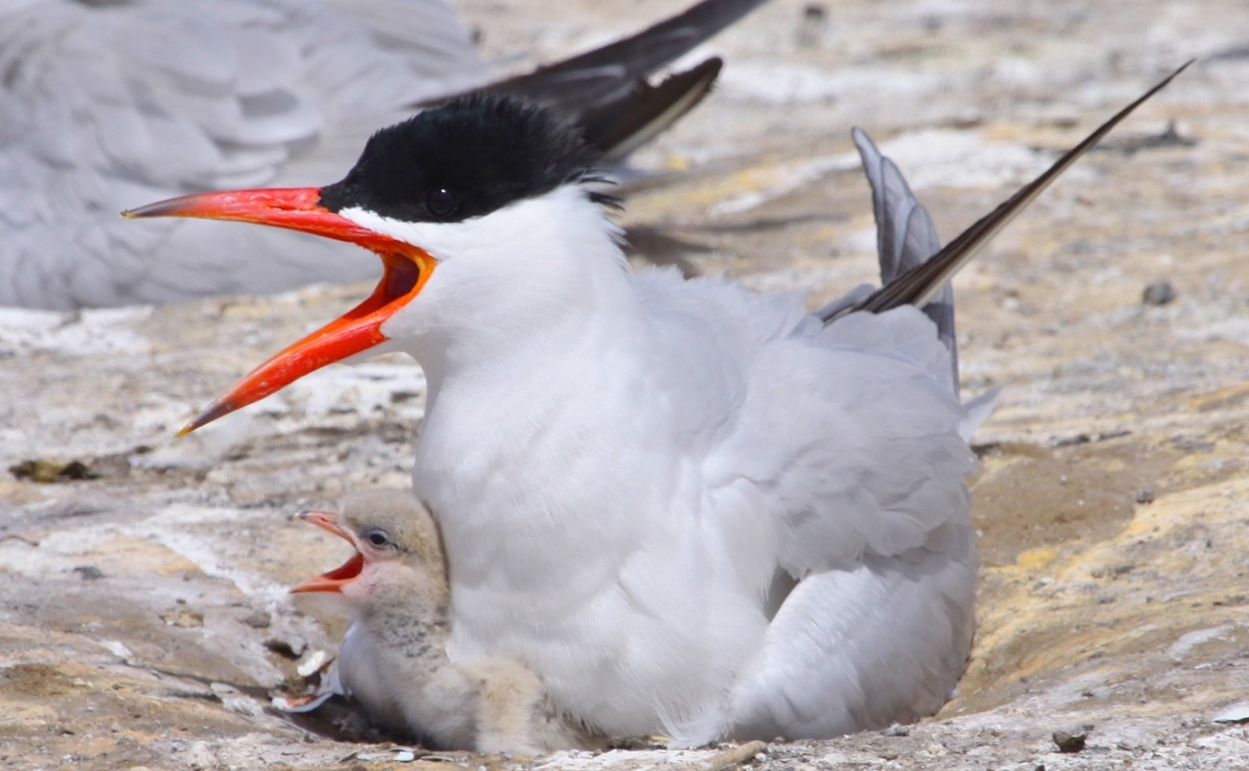Management Actions Have Reduced Predation On Fish By Caspian Terns In The Columbia River Estuary
- September 14, 2018
- John Harrison

A management plan to reduce predation by Caspian terns on fish in the Columbia River, particularly salmon and steelhead smolts as they migrate to the ocean in the spring, appears to be working, the research scientist who directs the effort told the Council at its September meeting.
Caspian Terns are a native species to the Northwest and are protected under the 1918 Migratory Bird Treaty Act. For at least the last 10 years, the population of terns nesting in the Columbia River estuary has alarmed fisheries managers, as the birds prey on small fish including salmon and steelhead smolts. Research and monitoring to reduce the predation began in 1997.
The tern nesting season largely overlaps with the time juvenile salmon and steelhead are migrating to the ocean, in the spring and early summer. Predation by fish-eating birds – terns, double-crested cormorants, and gulls – is considered a major source of mortality for some Endangered Species Act-listed salmon and steelhead populations in the Columbia River Basin.
The research resulted in a management plan and actions to reduce the predation, including encouraging a large tern colony on Rice Island east of Astoria to relocate about 10 miles downriver to East Sand Island, which is closer to the mouth of the river. Near East Sand Island the mix of fish in the water includes more forage fish like herring and fewer salmon and steelhead than near Rice Island. Also, passive deterrents like pole-mounted streamers that wave in the wind and snow fencing were installed on the beaches where terns prefer to nest. These were successful, and by 2007 the bulk of the colony moved to East Sand Island, where a nesting area was provided and subsequently reduced in size from six acres to one acre over time. Simultaneous with shrinking the East Sand nesting area, alternative nesting sites were provided at six locations in Oregon and Northern California – terns migrate very long distances.
The goal is to reduce the colony from 9,400 breeding pairs to 3,125 (there are 5,000 pairs in 2018). Before the control effort began, it was believed that Caspian terns killed as many as 25 million smolts annually, or about 15 percent of the juvenile fish in the estuary migrating to the ocean.
“The impact in the estuary has not been trivial,” the chief researcher, Dan Roby, of Bend, Oregon-based Real Time Research, told the Council. “However, management has resulted in a 50-percent reduction in breeding pairs in the estuary so there has been a sizable reduction.”
Predation also occurs in the Columbia River near the mouth of the Snake River, where terns were believed to be killing between 5 percent and as much as 30 percent of juvenile steelhead from some upriver populations annually. Gulls also may be responsible for a large number of smolt deaths each year, but that remains uncertain, Roby said.
As a result of the management actions, tern predation on smolts has been reduced by 50 percent or more, and thousands of birds are using the alternative nesting sites outside the Columbia River Basin. However, some of those alternative nesting sites, such as some in Southeastern Oregon, have suffered the effects of drought, and birds have not used them. As well, terns in the interior of Washington seem more resilient to management actions, and other terns have discovered the upper Columbia River estuary, where predation rates on salmon and steelhead are proving to be much higher than in the estuary.
Funding for the tern-control effort has come from multiple agencies but primarily and consistently from the Bonneville Power Administration, Roby said. However, the future of the research and management may be in jeopardy because of funding cuts. “Bonneville has notified us they will have to cut back management funding dramatically,” he said, adding that the other primary funder, the U.S. Army Corps of Engineers, which built Rice and East Sand islands with sand dredged from the river’s navigation channel, “has decided they are out of the tern management business.”



